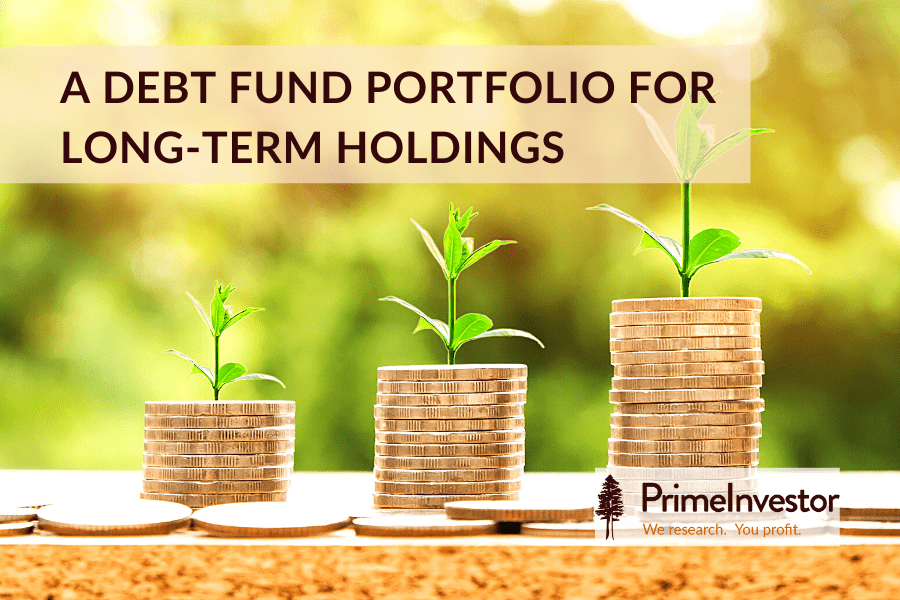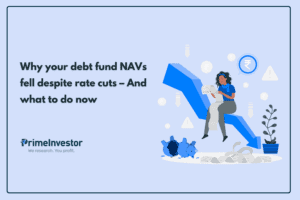A few weeks ago, we explained how you should invest in debt funds in the current interest rate scenario. There, we had covered where we are now in terms of rates and where we could be headed. We had also outlined strategies you can take in terms of your fixed-income investments based on the investing time frame you have.
Today, we’re going a step further and drawing up a debt fund portfolio you can use for a specific timeframe – and that is a timeframe that’s 3 years and longer.

Why this timeframe
You would wonder why we ignored short-term timeframes and are expanding only on the longer-term picture. Three reasons:
- For very short timeframes of less than 1 year, your options are limited to liquid/ultra-short/low duration funds and/or higher-returning bank fixed deposits. Similarly, for 2-3 years timeframes, you only have to swap out for short-duration or floating rate funds. In these timeframes, there is not much choice at hand for blending fund types or maturities.
- In longer-term timeframes, the unpredictability of the rate cycle hits harder. Sitting in judgement over the duration strategy to play can cost either in terms of higher volatility or lower returns over time. At a time when rates appear stagnant and it’s unclear when rates will change direction and move upward, it pays to blend fund types to address risks and opportunities.
- Not just that, the choice of funds and categories is wider for longer timeframes. Further, this allows blending of different maturities in order to avoid having to make rate-cycle calls or worrying over missed opportunities.
Combining different maturities
In the strategy we had outlined earlier, we had recommended a mix of shorter and longer duration funds – i.e., blend floating rate, short-duration, and corporate bond funds. The reasons for such a blend are as follows.
One, different maturities behave differently based on the rate cycle. Investing in longer-duration funds at a time when rates are just starting to climb up will mean that you sit on lower returns for a good while. This happens because bond prices will fall in reaction to higher rates, sending fund NAVs and therefore returns down. Also, given that these funds run longer maturities, it will take time before the higher yields (from new papers they add) start reflecting in their portfolio returns.
Now, returns on these funds will eventually pick up once the rate changeover is through and even make up for lost time. But until that plays out, your fund returns will reflect poorly while volatility may move up. If you dislike debt fund volatility or you find it hard to handle low returns or yields in your debt fund portfolio, investing in corporate bond funds alone – even if you have the necessary timeframe – may be a hard proposition for you.
Lower-maturity funds, on the other hand, will see both bond prices fall to a smaller extent and also a quicker reflection of higher rates in portfolio yields. Floating rate funds are more uniquely positioned to effectively ride any change in the rate cycle.
The graphs below show the 6-month and 1-year returns of Aditya Birla Sun Life Floating Rate and HDFC Corporate Bond funds, from 2016 to 2019. While we have been in a falling rate cycle for the most part in the past 6-7 years, a brief period between mid-2017 and 2018 saw repo rates move a shade up. looking at how returns panned out in this period will help draw an idea of how returns behave when rates shift higher.
As you will observe, the longer-maturity HDFC Corporate Bond dips steeper and returns take longer to recover than ABSL Floating, whose floating-rate portfolio adapts quicker.
Therefore, by adding a short-maturity fund along with a longer-term fund, it helps reduce the impact of volatility in short-term moves. For example, 6-month return deviation for ABSL Floating Rate over the past 3 years is just 1.13% against HDFC Corporate Bond’s 1.7%. Kotak Bond - Short Term’s 6-month return standard deviation is in-between, at 1.5%. Combining these will therefore involve lower volatility than simply going with a corporate bond fund alone.
Two, when the RBI will raise rates is unclear. As explained in our earlier report, there are several factors at odds with each other – rising inflation that is yet to be firmly under control, the RBI’s disinclination to let yields rise in the face of slower growth and government borrowings, and that big factor of US inflation and the US Fed action. Basing duration decisions when rates are stagnant and the outlook uncertain is best avoided. Using a mix of short and long maturity funds removes the need for, and the risk in, predicting where rates are headed.
Should rates move higher, both floating rate and short-duration funds will quickly pick up on better yields. For example, Kotak Bond Short Term’s portfolio yield has begun picking up; yields in July, for instance, were at 5.27% picking up from the low of 4.77% in November 20 and still hold above this level, as debt markets push to factor in a possible rate hike. Yields for HDFC Corporate Bond, on the other hand, have not picked up as quickly and are still marginally below year-ago levels.
Longer-maturity corporate bond funds will eventually see portfolio yields improve - and this in turn cushions returns through both higher yields and appreciation in bond prices when the rising rate cycle eventually plateaus or turns lower.
Three, investing across maturities will also make it easier for you to liquidate with reasonable returns if the need crops up. Locking into longer maturities means higher volatility and lower returns in the short-term, making it trickier for you to redeem any part of your debt investments.
Four, a portfolio staggered across maturities works like a charm no matter what the rate cycle scenario is, as each maturity profile compensates for lower returns or volatility in the others. You would not have to change around strategies later down the years if we start to shift from a higher to a lower rate cycle, making such a debt portfolio an all-weather one. The same concept can be used even if the debt funds form part of an asset-allocated portfolio.
The debt fund portfolio
You haven’t worked it out already? Well, here goes – as explained above, our recommendation is a mix of floating rate, short-duration, and corporate bond funds. The portfolio we recommend is as below.
The minimum timeframe for this portfolio is 3 years – you can hold for any number of years beyond this. The corporate bond fund gets the highest weight because over the long term, this set of funds returns better than shorter-term categories. A lower allocation would reduce the benefit of higher long-term yields and bond price appreciation opportunities. All three funds we have picked are part of Prime Funds. The reasons for these choices are outlined below; this apart, we also aimed at mixing funds from different AMCs to avoid concentration as AMCs take a similar decision on rate direction across their debt funds.
- Aditya Birla SL Floating Rate fund has traditionally maintained a shorter average maturity (among the reasons it features in our 3 months – 1.5 year bucket in Prime Funds), making it very suitable to allow a quick reflection of rate changes. It’s a low-volatile fund within its category and less likely to slip into losses even in very short timeframes. It also delivers comparably well with ultra-short/low duration funds. Other floating rate funds have relatively longer-term papers, and thus compete with short duration funds.
- Kotak Bond Short Term is similarly a low-risk fund in the short duration category. It delivers returns far better than the category (which houses funds that take credit risk), and is less volatile allowing for better risk-adjusted return. It holds only high-quality papers in its portfolio and is a consistent performer.
- HDFC Corporate Bond is among the most established corporate bond funds. Its strategy helps it squeeze the best out of each rate cycle, allowing it to sustain strong returns over the long-term. Its average 3-year rolling return in the past 6-year period, at 8.67%, is well above the category’s 7.8%. The fund is among the most consistent in its category, and has held steadily in the top quartile. While it doesn’t change portfolio maturities drastically, it does shift around based on the rate cycle.
Now, do you shift your existing debt funds to match this recommended portfolio? No, please don’t! You can modify the portfolio above, or retain your own investments, based on the points below:
- If your existing funds match your timeframe, even if they are just corporate bond funds, or medium duration or gilt funds, stay invested in them. In the long-term, these funds will deliver optimum returns. There is no necessity to add funds if you’re comfortable with short-term return dips.
- If you hold a different set of categories, and these categories meet the aim of investing across maturities, continue to hold. For example, if you hold an ultra-short duration fund or a banking & PSU fund along with a corporate bond, medium duration or even a gilt fund, continue with it. What you need to aim for is investing across maturities.
- Similarly, if you hold a different set of funds from the same categories, remain invested in them (provided they are Buys or Holds in our MF Review Tool) and avoid changing over. For example, while we have picked ABSL Floating for its short maturities, the concept of a floating rate fund will still hold good even if you’re invested in other funds in the category. Simply brace for higher volatility.
- If you have surplus to invest, you can deploy this into the funds given in the portfolio to bring your investments in line with our recommended portfolio.
- If you have large sums to invest, you can add funds from the same categories, or even similar ones such as banking & PSU (for short duration) or ultra short/low duration/ money market (for floating rate funds). For corporate bond funds, you can add more from the same category (check Prime Funds). Unless you are able to assess risks, avoid adding medium-duration funds and credit risk funds.







28 thoughts on “Prime Recommendation: A debt fund portfolio for long-term holdings”
Hi. Would a 25%-30% allocation within the debt portfolio in target maturity funds maturing in 5-6 years from now be a good decision?
If the maturity fits your timeframe and the yield is reasonable compared to other options, yes, you can go for it. But including a target maturity fund doesn’t make it a portfolio for all rate scenarios; you’re essentially locking into a particular yield. – thanks, Bhavana
Very informative article.. One question. How is this Kotak fund faring when compared to their corporate bond fund which is in your Prime funds.
Regards, Praveen
Do you mean Kotak Short Term vs Kotak Corporate Bond? They’re two different funds, and can’t really be compared. Both funds are part of the Prime Funds list, so you may invest in either, or both. Our aim was to have a mix of AMCs as well, and we picked HDFC Corporate Bond in the corporate bond space. – thanks, Bhavana
Given that good corporates are getting money cheaply, corporate bond funds YTM will not increase. However, due to duration risk, will corporate bond funds not drastically underperform because the average maturity is higher
The point in including floating rate and short-term funds is to reduce the duration risk. If the rate cycle rises, then yields will certainly move higher eventually. – thanks, Bhavana
Awesome article, Bhavana! Thanks loads for this detailed analysis. I am wondering why you specifically picked out HDFC Corp Bond Fund. The rolling return analysis shows that ICICI Pru Corp Bond Fund also did a pretty good job over the years and both the funds have excellent credit quality portfolio. Could your selection be due to the recent portfolio change of the latter fund that raised the average maturity to ~ 6 years making it more volatile in a rising rate scenario? I’m just curious. Thank you.
Well, there are 4 funds that we recommend in that Prime Funds bucket 🙂 They’re all worth investing in! We just picked HDFC Corp Bond given its steady nature and very long track record in delivering consistent returns. – thanks, Bhavana
Would I be right to ask if the average return would be in the range of 8 to 8.5% p.a if one invested in this portfolio for the recommended period of time ?
We can’t comment on how returns will pan out. We’ve also only given the minimum timeframe to hold, you can hold for any number of years after that. Based on past performance, it was in the range of 7.3-8.6% if we consider 3-year returns alone. – thanks, Bhavana
How about just 1 gilt fund for the long term debt portfolio for retirement ? Do we need across maturities ?
Yes, one gilt fund is fine. See the first point in the last section of the article. You just need to be willing to take the low returns that will come when rate cycle moves from downward to rising. It is not necessary to invest across maturities. In our experience, investors find it hard to see return dips in debt, and using different maturities helps to limit this risk. – thanks, Bhavana
Thanks Bhavana. What do you think of sip in gilt to reduce volatility ?
You can SIP in gilt, since it is volatile in the short-term. But don’t expect too much out of it – the volatility is nowhere near that of equity, where SIPs may really help average costs. We have written on SIP in debt in detail here, please read: https://www.primeinvestor.in/should-you-run-an-sip-in-debt-funds-or-in-lumpsum/ – thanks, Bhavana
Excellent article. Debt funds are the most confusing instruments out there. Excellent effort here to cut the clutter and simplify it for most of us.
Couple of questions remains for me though.
1. In the table you have shown average maturity for the 3 funds. Is that the metric one should keep in mind while choosing a fund of appropriate duration or is it the modified duration?
2. What’s the trade-off between choosing HDFC Corp Bond fund for long duration vs. say SBI Magnum Constant Maturity Gilt fund (which is part of the PrimeInvestor recommended funds)?
Some clarification on this is much appreciated. Thanks.
Thanks! We generally go by average maturity when looking at funds and portfolios. That gives a better idea on timeframes needed besides fund strategy. You can go for SBI Constant Maturity instead of HDFC Corp – just that volatility in the former will be higher and it will need at least 5 years in holding period. – thanks, Bhavana
Excellent analysis – especially giving intrinsic details and backdated charts to make the user understand the logic behind recommendation.
Especially like the last section where recommendation to existing user to drop the portfolio and jump to new one. Keep up great work!
Thank you 🙂 – Regards, Bhavana
Can we invest in this debt portfolio if I rebalance my portfolio once a year?
Not very clear on the question…if you mean that you invest in these funds at the time of rebalancing your portfolio, yes, it’s fine to invest in these funds at any point. Just that your rebalancing may not actually require you to exit any equity to reinvest in debt. – thanks, Bhavana
Super useful analysis and clear recommendations. Thanks
Thanks! – Regards, Bhavana
Comments are closed.